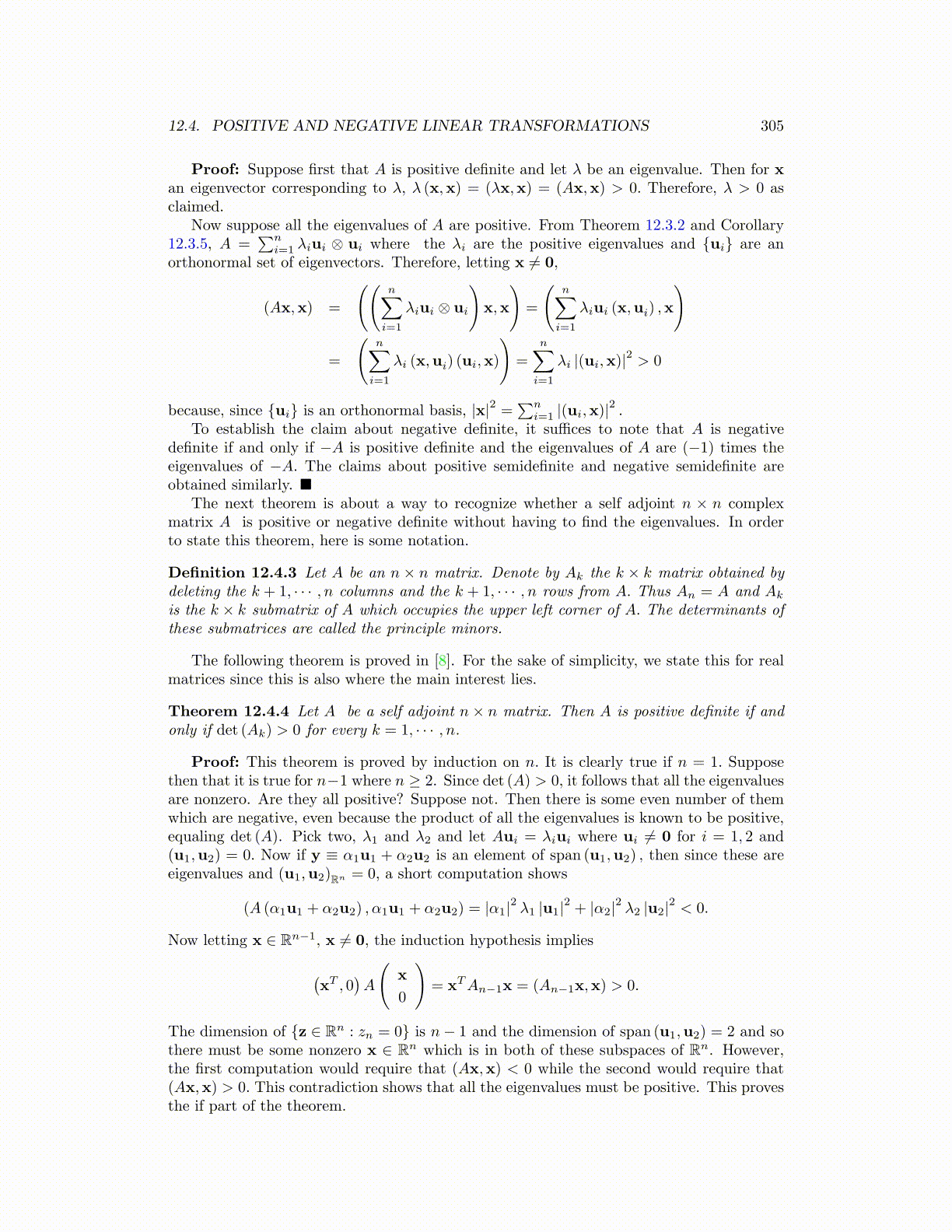
12.4. POSITIVE AND NEGATIVE LINEAR TRANSFORMATIONS 305
Proof: Suppose first that A is positive definite and let λ be an eigenvalue. Then for xan eigenvector corresponding to λ, λ (x,x) = (λx,x) = (Ax,x) > 0. Therefore, λ > 0 asclaimed.
Now suppose all the eigenvalues of A are positive. From Theorem 12.3.2 and Corollary12.3.5, A =
∑ni=1 λiui ⊗ ui where the λi are the positive eigenvalues and {ui} are an
orthonormal set of eigenvectors. Therefore, letting x ̸= 0,
(Ax,x) =
((n∑
i=1
λiui ⊗ ui
)x,x
)=
(n∑
i=1
λiui (x,ui) ,x
)
=
(n∑
i=1
λi (x,ui) (ui,x)
)=
n∑i=1
λi |(ui,x)|2 > 0
because, since {ui} is an orthonormal basis, |x|2 =∑n
i=1 |(ui,x)|2 .To establish the claim about negative definite, it suffices to note that A is negative
definite if and only if −A is positive definite and the eigenvalues of A are (−1) times theeigenvalues of −A. The claims about positive semidefinite and negative semidefinite areobtained similarly. ■
The next theorem is about a way to recognize whether a self adjoint n × n complexmatrix A is positive or negative definite without having to find the eigenvalues. In orderto state this theorem, here is some notation.
Definition 12.4.3 Let A be an n× n matrix. Denote by Ak the k × k matrix obtained bydeleting the k + 1, · · · , n columns and the k + 1, · · · , n rows from A. Thus An = A and Ak
is the k × k submatrix of A which occupies the upper left corner of A. The determinants ofthese submatrices are called the principle minors.
The following theorem is proved in [8]. For the sake of simplicity, we state this for realmatrices since this is also where the main interest lies.
Theorem 12.4.4 Let A be a self adjoint n× n matrix. Then A is positive definite if andonly if det (Ak) > 0 for every k = 1, · · · , n.
Proof: This theorem is proved by induction on n. It is clearly true if n = 1. Supposethen that it is true for n−1 where n ≥ 2. Since det (A) > 0, it follows that all the eigenvaluesare nonzero. Are they all positive? Suppose not. Then there is some even number of themwhich are negative, even because the product of all the eigenvalues is known to be positive,equaling det (A). Pick two, λ1 and λ2 and let Aui = λiui where ui ̸= 0 for i = 1, 2 and(u1,u2) = 0. Now if y ≡ α1u1 + α2u2 is an element of span (u1,u2) , then since these areeigenvalues and (u1,u2)Rn = 0, a short computation shows
(A (α1u1 + α2u2) , α1u1 + α2u2) = |α1|2 λ1 |u1|2 + |α2|2 λ2 |u2|2 < 0.
Now letting x ∈ Rn−1, x ̸= 0, the induction hypothesis implies
(xT , 0
)A
(x
0
)= xTAn−1x = (An−1x,x) > 0.
The dimension of {z ∈ Rn : zn = 0} is n− 1 and the dimension of span (u1,u2) = 2 and sothere must be some nonzero x ∈ Rn which is in both of these subspaces of Rn. However,the first computation would require that (Ax,x) < 0 while the second would require that(Ax,x) > 0. This contradiction shows that all the eigenvalues must be positive. This provesthe if part of the theorem.